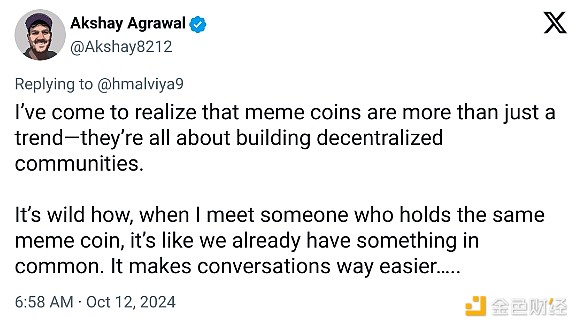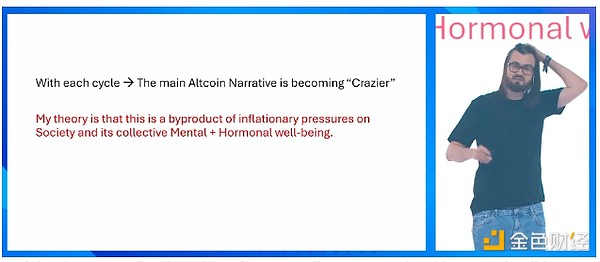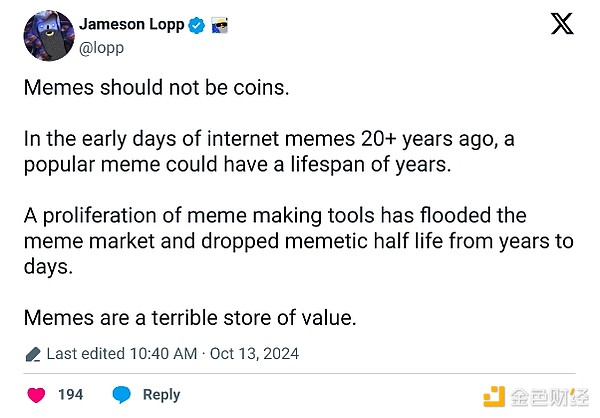Author: Daniel Ramirez-Escudero, CoinTelegraph; Translator: Deng Tong, Golden Finance
Investor and Memecoin analyst Murad Mahmudov's Memecoin Super Cycle Theory has gained traction among traders.
In short, the theory states that a combination of factors will create an essentially never-ending super cycle for meme-centric cryptocurrencies.
But unlike other cryptocurrency market narratives with complex technical explanations and mechanisms, meme coins seem to rely entirely on community, emotion, and the promise of wealth.
Despite the lack of fundamentals for meme coins, traders are attracted by the sense of camaraderie and the promise of quick gains.
Kyle Kemper, who developed political meme coins such as Make America Healthy Again (MAHA), believes that the Memecoin supercycle does not mean the death of fundamental analysis, but rather a shift in the indicators used.
He noted: "Critical analysis of projects, teams, and missions is being replaced by factors such as the strength of the project's key opinion leader (KOL) game and volume and chart performance."
The apparent success of the Memecoin Supercycle Theory among cryptocurrency traders suggests that their preferences are skewed.
“Meme coin investors are looking for returns in 24 hours or less, while the typical venture capital firm’s outlook is seven years.”
Basel Ismail, CEO of investment analysis platform Blockcircle, attributed the rise of meme coins to the increasing maturity of cryptocurrency traders, and said that many traders have gone through at least one market cycle and learned valuable lessons from their experiences.
Ismail believes that veteran cryptocurrency traders have realized that most tokens that aim to provide technological solutions (so-called utility tokens) lack real intrinsic value and utility beyond speculative price movements. Mahmudov touched on this issue during his Token2049 presentation, citing the view of one user X:
"Almost all crypto is a smokescreen designed to sell you useless tokens."
Ismail believes that the valuation of most utility tokens stems from their meme component, estimating that about 70% of utility token value is driven by speculation.
He said that traders are wary of "getting burned again" after past experience, after watching cryptocurrency projects with so-called solid technical foundations soar 100 times in three months, only to plummet 99% in the same period.
"Right now, traders are behaving like sheep. They are just shifting their attention and capital to memes."
Ismail said that "very strong anti-venture capitalism and anti-private equity sentiment" has also driven the development of meme coins.
He explained that investors feel misled by venture capitalists, who often release locked tokens on centralized exchanges and then dump them on unsuspecting retail investors.
"Fundamentally, meme coins don't try to deceive you, lie, and try to make false promises and unfulfilled expectations. People value that."
The love of memes combined with the power of imitation creates a social and psychological phenomenon where people want to unite with like-minded people. "We come together to share common beliefs," Ismail said.
Ismail noted that while this motivation may seem superficial to some, the power of shared ideals in a community of investors is enormous. He cited the unprecedented phenomenon of the AMC and GameStop stock runs. “They unite and bring together a young, vibrant and energetic community around an ideal or idea that enables them to make a lasting impact.”

Source: Akshay Agrawal
Memecoin Super Cycle Is Unsustainable
Despite the apparent success of the memecoin super cycle, some have expressed skepticism about its long-term sustainability. Jameson Lopp, co-founder of cryptocurrency custodian Casa, noted that he believes the meme coin craze is unlikely to last and may be misguided. Crypto Rand, a pseudonymous cryptocurrency market analyst and trader, explained that the meme coin economy thrives on hype and is driven by impulsive traders chasing a quick buck. This mentality fuels extreme volatility and a rapid chain reaction of liquidations. Crypto Rand noted that the success of meme coins lies in their marketing and hype, comparing them to fast-changing clothing trends.

97% of memecoins have died since 2024. Source: Chainplay
Crypto Rand said he sometimes puts money into memecoin and said it has the same value as betting on football games or the US election.
“Memes can hardly be an ‘investment’, but only a quick trade.”
Angel Versetti, founder and owner of the Dogecoin Foundation, criticized Mahmudov’s supercycle theory, noting that it is based on the idea that investors become irrational due to changes in collective psychology and hormones.
He concluded that “the state of investors in the meme coin financial market basically indicates that they suffer from mental illness.”

Murad Mahmudov’s slides referring to collective psychological and hormonal health. Source: Token2049
For Versetti, a market model that bases its growth on a “greater degree of delusion” among market participants “doesn’t sound like a sustainable economic model.”
Since meme coins have no intention of creating any utility, they can only continue to grow “purely due to the growing delusion of investors,” he said.
Versetti explained that initial coin offerings go through a similar process, with investors having only a 1% chance of success, but at least some people “trying to have a vision and build something.”
He pointed out how a number of legitimate tokens have emerged from the explosion of ICOs, such as Tezos, Cosmos, Chainlink, BNB, and Basic Attention Token, among others.
Lopp believes that in the long run, the market will solve such delusional investments because "projects that build castles in the clouds are doomed to revert to their true value of zero."

Source: Jameson Lopp
Lopp advocates for projects that provide solutions or tokens that are useful for any activity, especially if the project requires a sustainable life cycle.
“Projects that focus on providing real utility and value rather than zero-sum games will do well as long as they ignore the hype and continue to move towards their goals,” he said.
Kapil Dhiman, CEO of quantum-resistant digital ledger Quranium, noted that “Utility tokens are not just speculative vehicles, but are also an important part of the decentralized ecosystem.”
“Without this strong technological foundation, the entire blockchain industry is at risk of stagnation,” he said. […] Memes may generate quick profits, driven by speculative frenzy, but they cannot sustain long-term growth and credibility in the space.”
Mahmudov Benefited Hugely from the Memecoin Hype
Observers also noted that Mahmudov personally stood to profit from the proliferation of his memecoin narrative.
Lopp said: “Some people will happily delude themselves that they will magically become rich for one reason or another, usually because someone with an actual get-rich-quick scheme needs them to believe in a narrative.”
On Oct. 9, on-chain investigator ZachXBT claimed that Mahmudov allegedly holds $24 million in Meme Coin.
This may suggest that he is true to his word, but it also suggests that he could benefit greatly from the takeoff of the Meme Coin supercycle narrative.
On-chain analytics platform Lookonchain reports that Mahmudov has made $23.6 million in just four months, thanks to the surge in Meme Coin SPX6900 (SPX).
Lopp said that Meme Coin’s success reflects the nature of a permissionless system in which people will inevitably do stupid or even scam things.
 JinseFinance
JinseFinance
 JinseFinance
JinseFinance XingChi
XingChi JinseFinance
JinseFinance JinseFinance
JinseFinance Cheng Yuan
Cheng Yuan Xu Lin
Xu Lin Beincrypto
Beincrypto Bitcoinist
Bitcoinist Beincrypto
Beincrypto Cointelegraph
Cointelegraph